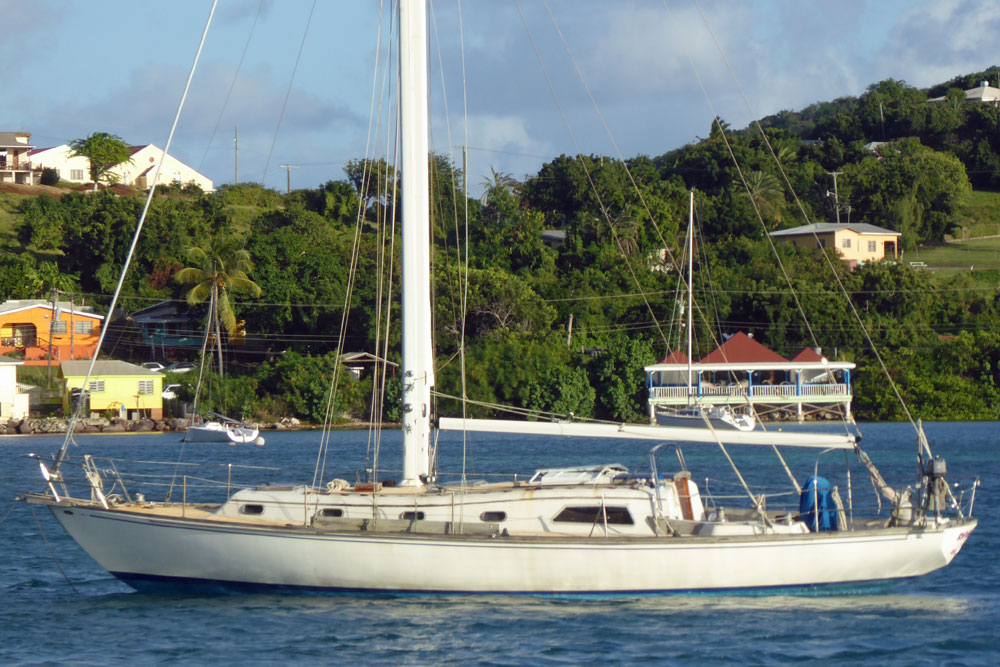- Home
- Cruising Yachts 40' to 45'
- Islander 44
The Islander 44 Sailboat
Specs & Key Performance Indicators
The Islander 44, a masthead sloop, was designed by William Lapworth and built in the USA by Wayfarer Yacht Corp.
Published Specification for the Islander 44
Underwater Profile: Fin keel with spade rudder;
Hull Material GRP (Fiberglass);
Length Overall: 43'10" (13.36m);
Waterline Length: 32'6" (9.9m);
Beam: 11'0" (3.4m);
Draft: 5'10" (1.78m);
Rig Type: Masthead Sloop;
Displacement: 22,500lb (10,206kg);
Designer: William Lapworth;
Builder: Wayfarer Yacht Corp (USA);
Year First Built: 1966;
Number Built: 10
Published Design Ratios for the Islander 44
Sail Area/Displacement Ratio: 16.4
Ballast/Displacement Ratio: 35.6
Displacement/Length Ratio: 293
Comfort Ratio: 39.7
Capsize Screening Formula: 1.6
Summary Analysis of the Design Ratios for the Islander 44
1. A Sail Area/Displacement Ratio of 16.4 suggests that the Islander 44 will, in the right conditions, approach her maximum hull speed readily and satisfy the sailing performance expectations of most cruising sailors.
2. A Ballast/Displacement Ratio of 35.6 means that the Islander 44 will have a tendency to heel excessively in a gust, and she'll need to be reefed early to keep her sailing upright in a moderate breeze.
3. A Displacement/Length Ratio of 293, tells us the Islander 44 is clearly a heavy displacement cruising boat. You can load her down with all your cruising gear and equipment and it will hardly affect her waterline. Not an ideal choice for coastal sailing, but she'll come into her own on an offshore passage in testing conditions.
4. Ted Brewer's Comfort Ratio of 39.7 suggests that crew comfort of a Islander 44 in a seaway is similar to what you would associate with the motion of a moderate bluewater cruising boat - a predictable and acceptable motion for most seasoned sailors.
5. The Capsize Screening Formula (CSF) of 1.6 tells us that a Islander 44 would be a safer choice of sailboat for an ocean passage than one with a CSF of more than 2.0.
Article: Islander 44 Sailboat
The Islander 44 is a 13.4 m monohull sloop designed by C. William Lapworth and built by Islander/Tradewind Yachts starting in 1962.
Overview
The Islander 44 is a moderate weight sailboat that is a reasonably good performer. It has a fin keel and a spade rudder, which give it good maneuverability and stability. It has a sloop rig with a reported sail area of 75.5 m², which allows it to sail well in light to moderate winds. It has a Universal Unimite diesel engine with 72 HP and a fuel capacity of 227 litres, which provides reliable auxiliary power when needed. The Islander 44 is best suited as a bluewater cruising boat, as it has an excellent righting capability if capsized and a comfortable interior layout.
Accommodation
The Islander 44 can accommodate up to six people in three separate cabins. The forward cabin has a V-berth and a head with a shower. The main cabin has a U-shaped dinette to port and a settee to starboard, which can also be used as berths. The galley is located aft to port, and has a stove, an oven, a sink and ample storage space. The navigation station is opposite the galley, and has a chart table and an instrument panel. The aft cabin has two single berths and another head with a shower. The interior is spacious and well-ventilated, with plenty of natural light from the large windows and hatches.
Hull and Deck
The hull of the Islander 44 is made of fiberglass, which makes it strong and durable. The hull mold for the Islander 44 was originally used for the Lapworth 44, but was modified by Islander to have a longer keel. Some of the boats were sold as kits by Yachtcraft, and have different deck and coach roof profiles. The deck of the Islander 44 is also made of fiberglass, and has a non-skid surface for safety. The deck has wide side decks and a spacious cockpit with a wheel steering system.
Mast and Rigging
The mast of the Islander 44 is deck-stepped, which means it is supported by a compression post inside the cabin. The mast is made of aluminum, which makes it light and strong. The mast has two sets of spreaders, which help to support the rigging and reduce mast bend. The rigging of the Islander 44 is conventional, with stainless steel wire shrouds and stays. The rigging also has turnbuckles for easy adjustment of tension. The sails of the Islander 44 are made of dacron, which is a synthetic fabric that is durable and resistant to UV damage. The sails include a mainsail, a genoa, a jib and a spinnaker. The mainsail has slab reefing, which means it can be reduced in size by folding or rolling up sections of the sail. The genoa and the jib have roller furling, which means they can be rolled up around the forestay when not in use.
Keel and Rudder
The keel of the Islander 44 is a fin keel, which means it is narrow and deep. The fin keel gives the boat good performance upwind and reduces leeway. The keel also has a bulb at the bottom, which lowers the center of gravity and increases stability. The keel is made of lead, which makes it heavy and resistant to corrosion. The rudder of the Islander 44 is a spade rudder, which means it is attached to the hull by a single stock. The spade rudder gives the boat good responsiveness and control. The rudder is made of fiberglass, which makes it strong and lightweight.
This article was written with the assistance of Gemini, a large language model developed by Google. Gemini was used to gather information, summarize research findings, and provide suggestions for the content and structure of the article.
Recent Articles
-
Is Marine SSB Still Used?
Apr 15, 25 02:05 PM
You'll find the answer to this and other marine SSB-related questions right here... -
Is An SSB Marine Radio Installation Worth Having on Your Sailboat?
Apr 14, 25 02:31 PM
SSB marine radio is expensive to buy and install, but remains the bluewater sailors' favourite means of long-range communication, and here's why -
Correct VHF Radio Procedure: Your Questions Answered
Apr 14, 25 08:37 AM
Got a question about correct VHF radio procedure? Odds are you'll find your answer here...














